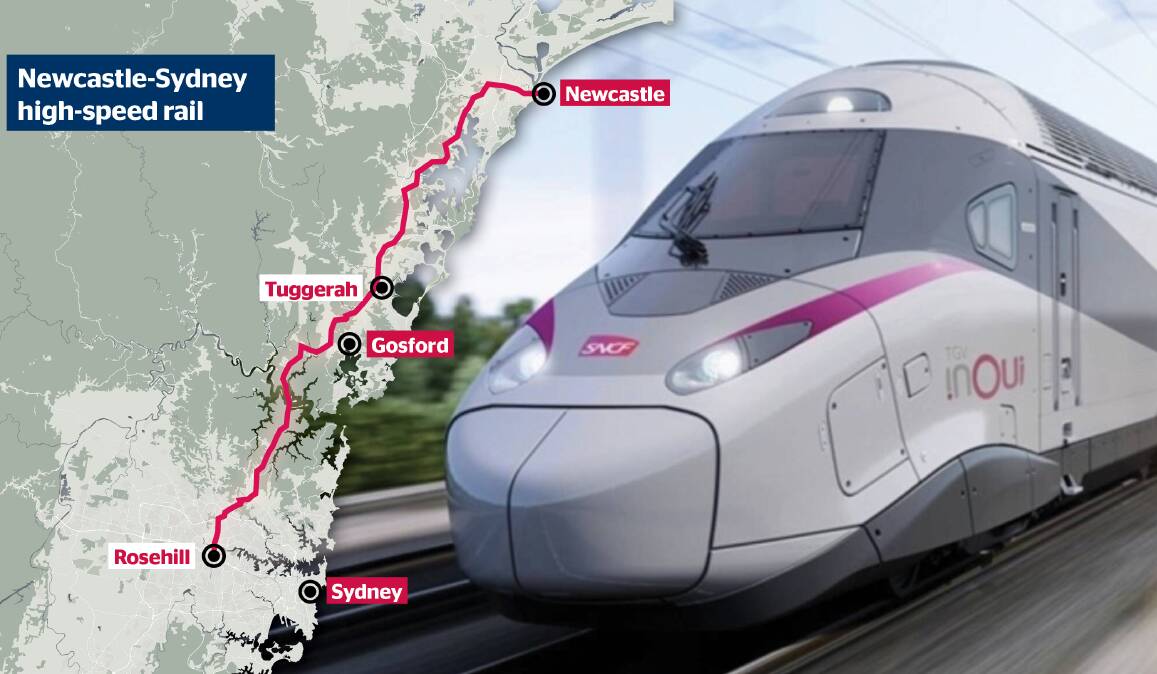
The High Speed Rail Authority has a gargantuan task ahead in writing a business case for the Newcastle to Sydney bullet train by the end of the year.
The government announced this week that it would spend $78.8 million on an "initial" business case which would include a preferred route, station locations, costs and the type of trains to be used.
The 168 kilometres between the two cities pose a host of strategic, engineering, technical, operational and financial questions, not to mention political considerations leading up to the 2025 federal election.
A government study in 2013 proposed a route from Central Station proceeding under Sydney to Hornsby then underground again to the Hawkesbury River, onwards via tunnels and above-ground track to a new station at Tuggerah then across the Hunter River west of Newcastle.
It remains to be seen whether the HSRA business case will recommend something similar to the Albanese government or a high-speed line which integrates more closely with the existing rail network.
How the government wants the network to operate will dictate station locations and the design of infrastructure such as tunnels, tracks and rolling stock.
Will bullet trains run to a terminus at Central Station or, as many transport experts have suggested, abandon the expensive-to-build Sydney CBD route and cut north-south through Rosehill or Homebush instead?
Is running high-speed rail to Central even possible any more given other large-scale developments under way or planned for the station?
Likewise, will a new line deliver passengers underground to Broadmeadow or Newcastle Interchange or will it also run further west through Hexham or Tarro?
Similarly, will it bypass Gosford to the west?
Under one scenario, fast trains could run on conventional tracks from Newcastle Interchange, join the high-speed line at Tuggerah then zoom on to Epping or Rosehill, where passengers would transfer to Sydney's new Metro underground lines and the rest of the city's rail network.
Such a trip could take about 75 minutes from Newcastle to Central Station and require one change of train.
Passengers from the growth areas around Maitland could drive or catch a train to Hexham then jump on a high-speed service south to Sydney or, eventually, north to Brisbane.
Other fast double-decker, inter-urban trains could make more stops in Newcastle and on the Central Coast before rejoining the high-speed line to Sydney at up to 220 kilometres an hour.
A more integrated high-speed network potentially offers more benefits for Newcastle and the Central Coast than a stand-alone service which would require passengers to change trains more often.
The government says the HSRA is still working towards an east coast network encompassing Brisbane, Canberra and Melbourne. Presumably, it will plan the first leg with this in mind.
Will the government, as Infrastructure and Transport Minister Catherine King has said, rely on at least some private sector involvement to pay for the project?
Will renting the line to a private operator make the service prohibitively expensive for many users?
Could the line be used at night to run interstate high-speed freight trains?
Will the line use 25-kilovolt high-speed trains or more flexible dual-voltage trains requiring at least some less expensive infrastructure?
Ms King visited England last year to inspect work on HS2, a high-speed line which was meant to connect London with Leeds and Manchester but which has been abbreviated over the past two years to stop at Birmingham.
One transport expert, who asked not to be named, suggested the government should look to Spain for a more established high-speed rail network with more in common with Australia.
Since 1992, the Iberian nation, with its comparatively sparse population of 43 million, has rolled out 4000km of high-speed rail between dozens of cities.
Spain's high-speed network burrows through mountainous terrain, something the Newcastle-Sydney line will have to overcome to accommodate bullet trains.
Aside from the myriad technical issues, the government must convince the community and industry that it is serious about building the line and not just using the business case to win votes or bury the project.
As recently as November, HSRA acting chief executive Andrew Hyles was expecting the business case to be complete in 2026.
The government faced pressure from the Opposition and the Greens before Christmas over its allegedly slow progress on the project since it formed the HSRA in the middle of the year.
One month later, the government had appointed the HSRA's first CEO, Tim Parker, and Ms King was telling reporters in Newcastle the business case would be ready by the end of the year.
That is a dramatic acceleration of what is expected to be a somewhat detailed analysis of one of the most complex and expensive infrastructure projects in Australia's history.
It is up to the government to prove this latest iteration is not just more fodder for another episode of Utopia.







